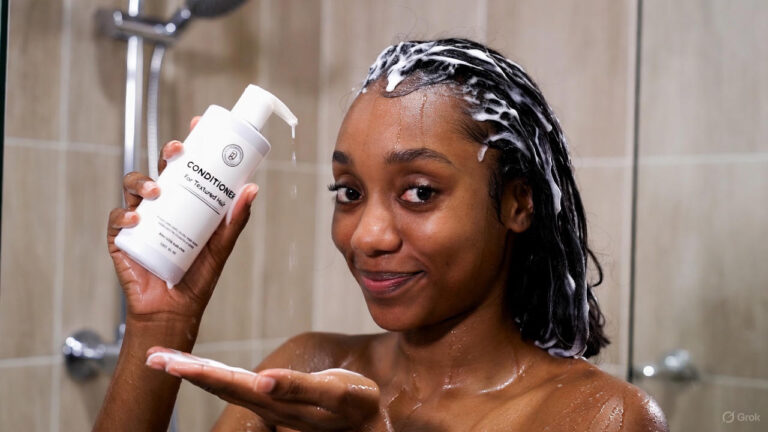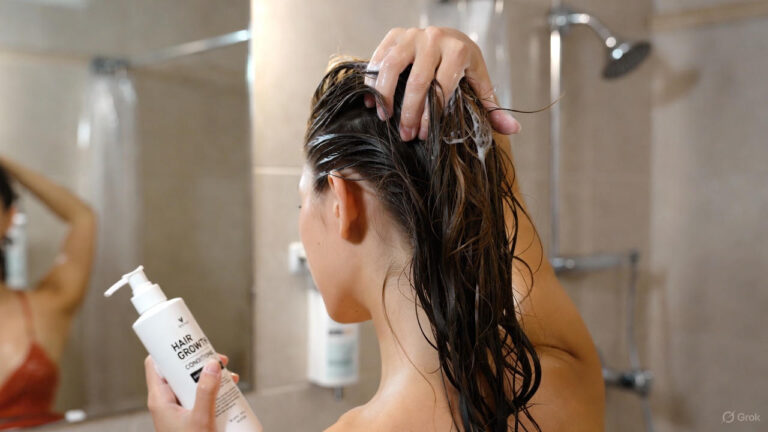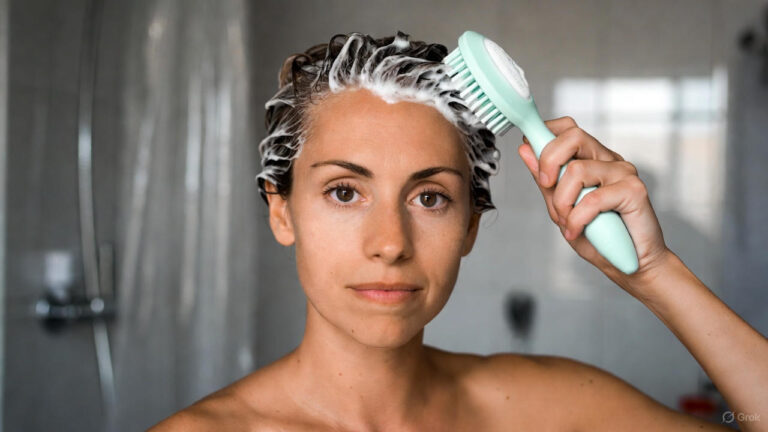Traveling exposes your hair to various environmental factors, such as humidity, temperature changes, and different water qualities, all of which can contribute to frizz. But fear not! By following these tips, you can keep your hair under control and maintain a gorgeous, frizz-free look no matter where your travels take you.
Tip 1: Pre-Trip Hair Care Routine
To combat frizz, it’s crucial to establish a pre-trip hair care routine. Begin by pampering your hair with deep conditioning treatments.
These treatments provide essential moisture and hydration, strengthening your hair and making it more resistant to frizz-inducing factors.
Consider using hydrating hair masks or leave-in conditioners that will nourish your hair and create a protective barrier.
Trimming your split ends before your journey is another essential step. Split ends can make your hair more prone to frizz, so a fresh trim will keep your hair healthy and less likely to frizz.
Additionally, choose shampoos and conditioners specifically formulated for hydration and frizz control. Look for products that contain ingredients like argan oil or shea butter, which help to moisturize and tame frizz.
Tip 2: Protective Hairstyles
Protective hairstyles are a game-changer when it comes to avoiding frizzy hair while traveling. These hairstyles shield your hair from external elements and reduce friction, preventing frizz and breakage. One popular option is braids—whether it’s classic braids, French braids, or cornrows, they keep your hair neatly in place and protect it from tangling and frizzing up.
If braids aren’t your style, opt for buns or top knots. These hairstyles not only look chic but also keep your hair secure and protected during your travels. To achieve a bun or top knot, gather your hair into a high ponytail, twist it around the base, and secure it with bobby pins or a hair tie. This style keeps your hair off your neck, preventing sweat-induced frizz and giving you a polished look throughout the day.
Tip 3: Minimizing Heat Styling
Excessive heat styling can be detrimental to frizzy hair, as it strips away moisture and exacerbates frizz. While it’s tempting to reach for your straightener or curling iron while traveling, it’s best to minimize heat styling as much as possible. Embrace your natural hair texture and opt for heat-free styling techniques instead.
Air-drying is a fantastic option when you’re on the go. After washing your hair, gently squeeze out the excess water with a microfiber towel or an old T-shirt.
Avoid rubbing your hair vigorously, as this can rough up the cuticles and create frizz. Instead, allow your hair to air dry naturally. If you’re short on time, consider braiding your wet hair before bed.
When you wake up in the morning, remove the braid, and you’ll have effortless, beachy waves.
If you desire more defined curls or waves, try using foam or fabric rollers. These heat-free alternatives create beautiful, long-lasting curls without the risk of heat damage.
Simply wrap small sections of damp hair around the rollers and secure them in place. Leave them in for a few hours or overnight, and when you remove them, you’ll have gorgeous, frizz-free curls.
Tip 4: Hair Accessories and Tools
Choosing the right hair accessories and tools can make a significant difference in managing frizz while traveling. Opt for silk or satin hair ties and scarves, which reduce friction and prevent breakage, resulting in less frizz.
Traditional elastic hair ties can tug on your hair and create tension, leading to breakage and flyaways. Instead, go for gentle, snag-free options that won’t cause damage.
When it comes to detangling, reach for a wide-toothed comb or a detangling brush. These tools are designed to glide through your hair, minimizing breakage and frizz.
Start by gently detangling your hair from the ends, and working your way up to the roots. This approach prevents unnecessary tugging and further damage.
Another essential tool for frizz control is anti-frizz hair products. Look for serums, oils, or sprays specifically formulated to combat frizz and provide extra moisture.
These products help smooth the hair cuticles, reducing frizz and leaving your hair looking sleek and polished. Apply a small amount to your palms and distribute it evenly through your hair, focusing on the mid-lengths and ends.
Tip 5: Humidity Protection
Humidity is a notorious enemy of frizz-free hair. When the air is humid, it carries excess moisture, which causes the hair to absorb it and swell, resulting in frizz. To combat this, it’s essential to protect your hair from high humidity levels, especially in tropical or coastal destinations.
Invest in anti-humidity hair products that contain ingredients like silicone or polymers. These products create a barrier around the hair strands, repelling moisture and preventing frizz.
Apply the product to damp hair before styling or on dry hair as a finishing touch. Additionally, consider hairstyles that keep your hair off your neck and minimize exposure to humid air.
Updos, such as high ponytails or top knots, are excellent options that will help combat frizz and keep you cool in humid climates.
Tip 6: Hydration and Moisture
Hydration plays a vital role in maintaining frizz-free hair. It’s not just about external care; internal hydration is equally important. Ensure you drink plenty of water throughout your travels to keep your body and hair well-hydrated. Hydrated hair is less likely to frizz and appears healthier and more vibrant.
In addition to drinking water, incorporate leave-in conditioners into your hair care routine. These products provide long-lasting moisture and hydration, keeping your hair smooth and frizz-free throughout the day.
After washing your hair, apply a small amount of leave-in conditioner to damp hair, focusing on the ends. Comb through your hair to distribute the product evenly and style as desired.
If you prefer natural remedies, consider making your own hydrating hair masks using ingredients like coconut oil, honey, or aloe vera. These ingredients are known for their moisturizing properties and can deeply nourish and revitalize your hair.
Apply the mask to damp hair, focusing on the mid-lengths and ends. Leave it on for the recommended time, then rinse thoroughly and style as usual.
Tip 7: Nighttime Hair Care Routine
Your nighttime hair care routine can greatly impact the frizz levels in your hair the next morning. Invest in a silk or satin pillowcase, as these materials create less friction than cotton, reducing hair breakage and frizz. Silk or satin pillowcases also help your hair retain moisture and prevent it from drying out overnight.
Consider incorporating a protective hairstyle into your nighttime routine. Loose braids or buns are excellent choices as they keep your hair in place and prevent tangling while you sleep.
Before bed, gently brush your hair to remove any tangles, and then create a loose braid or bun. Secure it with a scrunchie or a soft hair tie. In the morning, simply undo the braid or bun, and you’ll have effortlessly tousled hair with minimal frizz.
Conclusion
Say goodbye to frizzy hair ruining your travel experiences. By implementing these seven tips, you can enjoy smooth, frizz-free hair no matter where your adventures take you. Remember to establish a pre-trip hair care routine, embrace protective hairstyles, minimize heat styling, use the right accessories and tools, protect your hair from humidity, prioritize hydration and moisture, and follow a nighttime hair care routine.
FAQs
1. Can I still use heat styling tools while traveling?
While it’s best to minimize heat styling, we understand that there may be occasions when you want to change up your hairstyle. If you must use heat styling tools, be sure to apply a heat protectant spray before styling. This will help reduce the potential damage caused by heat.
2. How often should I deep condition my hair while traveling?
Deep conditioning treatments should be done once a week or every two weeks, depending on your hair’s needs. Adjust the frequency based on how your hair feels during your travels. If you’re in a particularly dry or humid climate, consider increasing the frequency to provide extra moisture.
3. Can I use regular hair ties and pillowcases if I don’t have silk or satin ones?
While silk or satin hair ties and pillowcases are ideal, you can still minimize frizz by using regular hair ties made from gentle materials like cloth or elastic without metal clasps. Similarly, a cotton pillowcase can be substituted with a microfiber towel or an old t-shirt wrapped around your pillow to reduce friction.
4. Are there any travel-friendly products for frizz control?
Yes, many brands offer travel-sized versions of their anti-frizz products, including serums, oils, and sprays. These smaller sizes are perfect for carrying in your travel bag and provide the same frizz-fighting benefits as their full-sized counterparts.
5. How can I maintain my protective hairstyle while traveling?
To maintain your protective hairstyle while traveling, carry a small travel-sized hairspray or hair gel to touch up any loose hairs or flyaways. Additionally, consider packing a few extra bobby pins or hair ties to secure any loose sections if needed.



